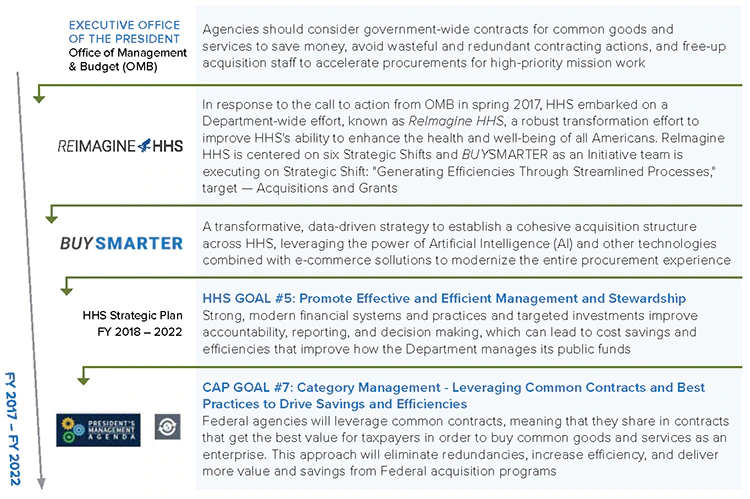In May 2017, the U.S. Department of Health and Human Services (HHS) embarked on a Department-wide effort known as ReImagine HHS (RHHS) in response to the Office of Management and Budget (OMB) Executive Memo M-17-22. The Executive Memo and the RHHS effort tasked agencies “to consider government-wide contracts for common goods and services to save money, avoid wasteful and redundant contracting actions, and free-up acquisition staff to accelerate procurements for high-priority mission work.” Through this effort, the BUYSMARTER initiative was born.
Figure 1: Paving the Way

BUYSMARTER maximizes HHS’ enterprise purchasing power to establish a cohesive acquisition structure across HHS in order to drive better pricing and achieve better terms and conditions, while consolidating the total number of contracts and shifting acquisition staff-time to higher-priority, mission-critical work. BUYSMARTER’s collaborative approach leverages AI technology to assist in analyzing spend data and identifying opportunities that support enterprise acquisitions.
Stakeholder engagement and mission focus are the foundations of the entire BUYSMARTER effort. As such, the HHS agency heads of contracting activity (HCA) have been engaged to form the members of the Planning and Development Committee (PDC) from the onset. Every aspect of the people, process, and technology for BUYSMARTER has been designed with their guidance. Category Collaboratives have also been created to lead each category and sub-category pursuit with volunteers from across HHS agencies. These teams will then launch Sub-Category Pursuit Teams on individual good or service acquisitions, which will bring together subject matter experts from all the buying agencies. This entire community participated in human-centered design sessions to develop the Full Contract Scan (FCS) AI Tool.
This is the journey of how BUYSMARTER is moving from an initiative to a program on October 1, 2020.

